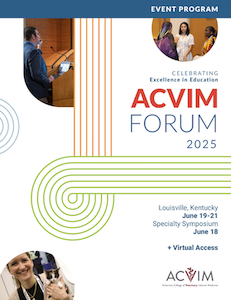Food Animal Internal Medicine
Assessing the Effectiveness of an Evidence-Based Algorithm for Antimicrobial Treatment in Neonatal Calf Diarrhea
Thursday, June 19, 2025
3:30 PM - 4:00 PM ET
Location: KICC L015
CE: 0.5 Medical

Luiza S. Zakia, DVM, DVSc, DACVIM (LA) (she/her/hers)
Assistant Professor
University of Guelph
Guelph, Ontario, Canada
Research Report Presenter(s)
Abstract: Background – Diarrhea is a major cause of mortality in calves, with antimicrobial drugs (AMD) being used in many cases. However, few guidelines for AMD use in calf diarrhea have been developed. Objectives – To evaluate the effectiveness of an evidence-based algorithm (EBA) for antimicrobial treatment of calf diarrhea. Animals – 106 neonatal calves. Methods – A blinded, non-inferiority, randomized controlled trial compared two treatments: (1) an EBA, in which calves were treated with AMD (trimethoprim-sulfadoxine 16mg/kg) only if they showed ≥2 of the following abnormalities: rectal temperature >38.8°C after anti-inflammatory medication (based on cut-off identified in a prior study), inability to stand, absent suckle reflex, sunken eyes, or scleral injection; and (2) a control group (CG), where all calves received AMD (trimethoprim-sulfadoxine) at diarrhea onset. All calves received enteral fluids for the duration of the diarrhea and meloxicam (0.5mg/kg) at the onset of disease. Cox survival analysis and logistic regression models assessed diarrhea duration, survival and the need for rescue treatment (i.e., additional AMD therapy). Results – In total, 40% (21/52) of the calves in the EBA group required AMD. Diarrhea duration was not different between groups (CG vs. EBA HR:0.78; 95%CI:0.52-1.16; P=0.22). Control calves had a trend toward higher mortality (OR:3.91; 95%CI:0.90-24.03; P=0.07) and more rescue treatments (OR:6.34; 95%CI:1.28-62.06; P=0.02) compared to EBA calves. Conclusions and Clinical Importance - The EBA did not affect diarrhea duration compared with the CG. However, the EBA trend for lower mortality risk suggests it may improve calf outcomes while reducing AMD use.
Learning Objectives:
- Evaluate the effectiveness of an evidence-based algorithm (EBA) for guiding antimicrobial treatment decisions in neonatal calves with diarrhea.
- Interpret clinical trial results comparing routine antimicrobial therapy versus selective treatment based on clinical signs, emphasizing mortality risk, diarrhea duration, and the requirement for additional therapy.
- Discuss the implications of applying an evidence-based algorithm on antimicrobial stewardship and calf health outcomes.


